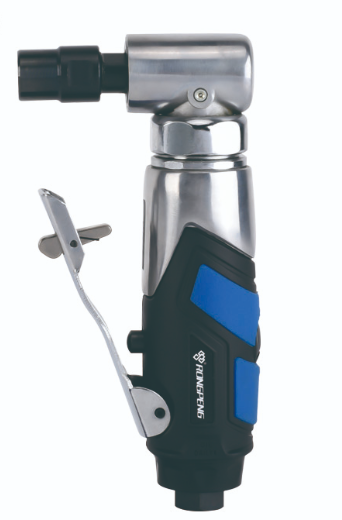

What is a Right Angle Die Grinder? The first thing we know about a straight air die grinder is that it can accommodate grinding heads. These grinding heads have the ability to cut, grind, and perform other functions to remove portions of material that need to be removed. The only difference with a straight air die grinder is that a right angle die grinder has a grinding head that is perpendicular to the body of the machine, allowing it to grind areas that are difficult or impossible to grind with a straight pneumatic die grinder. As a result, it can be used for grinding, trimming, deburring, holemaking and polishing in confined areas.
I would like to recommend RONGPENG RP27315 1/4 “ Right Angle Die Grinder, which is designed for precision machining in tight spaces. Whether you're working with metal, wood, plastic or other materials, the RP27315 is equipped with the right cutter head for optimal results. With a speed of up to 22000 RPM and a working pressure of 0.63 MPA, it provides plenty of power for a variety of grinding and polishing tasks. At only 0.49 kg, it is lightweight and easy to maneuver, reducing operator hand fatigue.

So what type of die grinder bit should you choose? Here are a few factors to consider when choosing the right die grinder cutter head for your air die grinder:
Material Factors
The type of material being processed is critical. For metals, tungsten carbide bit is the preferred choice. These bits, made from tungsten carbide, excel at shaping, deburring and smoothing a variety of metal surfaces. For harder materials such as stone, concrete, ceramics or glass, a diamond cutter bit is more suitable. diamonds are extremely hard and can effectively grind and cut these challenging materials.
For wood or plastic, the options are even wider. Carbide bit is still effective, especially when creating intricate designs or removing sharp edges. Wire brushes can be used to clean or prepare surfaces, while grinding wheels can be used for more intense smoothing or cutting tasks.
Workpiece size and shape
The size and shape of the workpiece will influence the choice of bit. Smaller or complexly shaped workpieces may require a precision bit such as a carbide bit or diamond bit to accomplish fine machining without damaging the surrounding area. Conversely, larger or flat surfaces may require grinding wheels or Mounted Stones to effectively cover more area.
Required surface finish
The finish you wish to achieve also informs your choice. For a smooth, polished finish, a carbide burr or diamond tip may be more appropriate. For a rough or textured finish, an abrasive wheel or wire brush may be more appropriate. Consider the specific needs of the application and how the type of cutter head will affect the final appearance and texture of the material.
Cost and Longevity
While initial cost is a consideration, the durability and longevity of the bit is equally important. Some high-quality bits may cost more upfront, but last longer, perform better and are more cost-effective. Evaluate the quality and suitability of the bit for your particular application to ensure it will stand up to the demands of the job.
Selecting the right die grinder is critical to obtaining the best results in a cutting or grinding application. Consider the type of material, the size and shape of the workpiece, the desired finish, cost, and service life,. By carefully evaluating these factors, you can select the most appropriate bit to ensure that you work efficiently